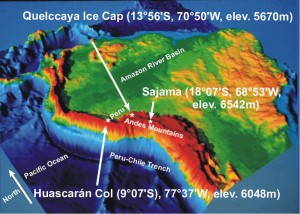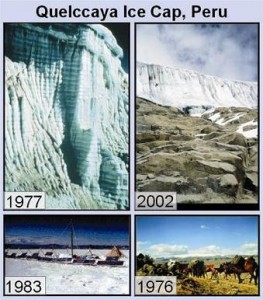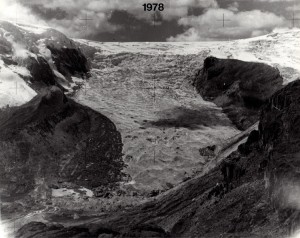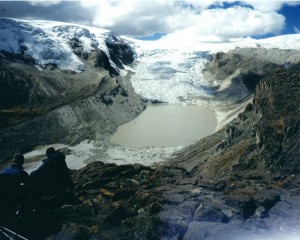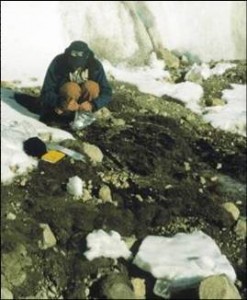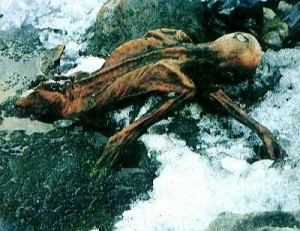Lonnie Thompson is a glaciologist who travels to ice caps in tropical and subtropical latitudes to drill ice cores that can provide detailed information about the climate of the past (paleoclimate). In 2002, an unexpected discovery and careful scientific analysis led to a better understanding of Earth’s climate more than 5,000 years ago!
Researcher: Lonnie Thompson
University/Organization: Byrd Polar Research Center at The Ohio State University
Research Location: Columbus, Ohio (and tropical and subtropical ice caps)
Ice Caps in the Tropics?
The phrase “tropical ice caps” seems to be an oxymoron, because generally we don’t associate glaciers with the tropical regions. However, snowcapped mountains are seen on all continents and at all latitudes, offering visual evidence of the cooling that occurs as a result of increasing elevation. Data from mountain glaciers show that, like the Arctic sea ice and polar ice sheets, these tropical ice caps are melting at an alarming rate due to global warming.
Lonnie selects places where the mountains are high enough to have had ice on them for thousands of years. The ice caps of the Andes Mountains of Peru were the first focus of his research outside the polar regions. In 1977, he traveled to the Qori Kalis glacier, which is an outlet glacier of the Quelccaya (pronounced like “kell-ky’-a”) ice cap of Peru. Since then he has traveled to three other ice fields in the Andes Mountains (see map below) and to fields in other locations around the world.
Lonnie has visited Qori Kalis many times since his first exploration of the area. He always takes a picture from the same spot to document where the terminus, or lowest edge, of the glacier is located. Measurements from those pictures, a process known as photogrammetry, can be used to assess the change in the mass of the glacier as well as the rate of change.
The upper left photo was taken in 1977. It shows a 50 meter (164 feet) ice cliff near the margin of the tropical Quelccaya ice cap (5,670 meters, or 18,602 feet, above sea level) which is located in the southeastern Peruvian Andes. The annual layers of accumulated snow (becoming ice) are clearly visible in this image. The photo in the upper right panel was taken from the same spot in 2002.
These photos of the Qori Kalis glacier were taken from a distance (and from the same exact location) in 1978 and 2006. They show the recent retreat of the ice margin of the Qori Kalis glacier in Peru. They also illustrate the loss of an important archive of past environmental and climate conditions. Note: The lake in the foreground formed as the glacier melted and retreated. It covers more than 80 acres.
A Surprising Observation
In 2002, Lonnie and his research team were walking on rock in an area that had been covered by ice just one year before. They noticed a dried and faded plant. What type of plant was it? How old was it? What kind of climate existed when the plant was alive? Because Lonnie works to describe the history of climate on Earth, knowing the age of the plant and the kind of conditions it grew in were important pieces of the puzzle.
Consultation and Collaboration
Lonnie knew that to answer these questions he would need the assistance of other scientists. He took pictures of the plant in place and with something for scale so the picture would be more helpful to others. He also made notes of the plant’s position and described the area around it. Then he carefully removed some of the plant and packaged it so that it could be shipped back to the United States for further analysis.
Back in his lab, Lonnie sent part of the plant specimen to a colleague at the Woods Hole Oceanographic Institute (WHOI) who does radiocarbon dating of fossils. He also sent part of it to the Lawrence Livermore National Laboratory for carbon dating. The scientists at these labs independently determined that the plant (a type of moss; Distichia muscoides) was about 5,200 years old!
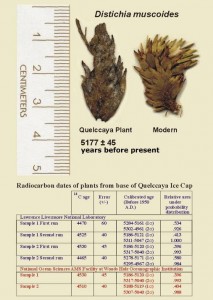
Blanca Leon, a scientist at the University of Texas at Austin, identified the Quelccaya plant by comparing it with a modern plant. Image courtesy of Ellen Mosley-Thompson.
The age of the plant puzzled and intrigued Lonnie. What had happened about 5,200 years ago that would have covered this plant with ice…enough to bury and preserve it for more than 5,000 years? This had to be a really big and long-term change in climate! He looked for other evidence of an abrupt change in climate at that same time elsewhere on the earth.
Putting It All Together
Lonnie checked the scientific literature and began to put the pieces of the puzzle together. He learned about several climate-related events that occurred about 5,200 years ago, suggesting a cooling period in the earth’s history.
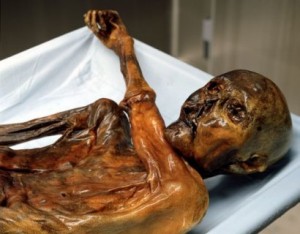
Otzi was discovered in the Tyrolean Alps in 1991. His remains have been radiocarbon dated to around 5,200 years old.
This was about the same time that advancing glaciers in the Alps region of Europe preserved the “Tyrolean Iceman” (or Otzi) who was discovered in 1991. Like Lonnie’s moss plant, Otzi was covered quickly by deep snow and remained frozen from that time until he was exposed by the retreat of a glacier. The Iceman’s remains have been radiocarbon dated to around 5,200 years ago.
Other natural recorders of past climate showing the same cool and wet period include: ice cores from Mt. Kilimanjaro in Africa, cave formations (stalactites and stalagmites) from Soreq Cave in southern Israel, and tree rings in both Ireland and England.
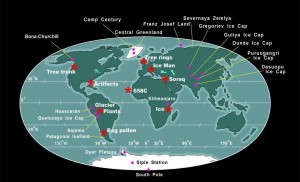
Global view of well-dated sites where the abrupt climate event of 5,200 years ago has been documented (as of April 2005). Image courtesy of Ellen Mosley-Thompson.
From a sociological point of view, this abrupt cooling event occurred just as hierarchical societies were forming in the Nile Valley and Mesopotamia. Some of the inner desert regions of Arabia were also abandoned at about the same time. Scientists believe that these shifts in social organization may have been, in part, an effort to adapt to more variable climate conditions, including cooler temperatures and changing water supplies.
The serendipitous discovery of the moss has helped Lonnie and other scientists learn more about the Earth’s paleoclimate. It also shows that unexpected events and observations can play an important role in scientific discovery. To make the most of these surprising events, scientists must be observant, make careful measurements and descriptions, consult with specialists when needed, read about the work of other scientists around the world, and communicate their findings and further questions – all characteristics of doing “good science.”
This article was written by Carol Landis. For more information, see the Contributors page. Email Kimberly Lightle, Principal Investigator, with any questions about the content of this site.
Copyright June 2008 – The Ohio State University. This material is based upon work supported by the National Science Foundation under Grant No. 0733024. Any opinions, findings, and conclusions or recommendations expressed in this material are those of the author(s) and do not necessarily reflect the views of the National Science Foundation. This work is licensed under an Attribution-ShareAlike 3.0 Unported Creative Commons license.

